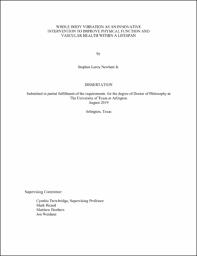| dc.description.abstract | Over the past several decades, technological advances in computers, transportation devices, and other automated devices have decreased the need for human locomotion and physical activity in the workplace and at home. The need to be physically active in order to sustain and prosper in life has been almost fully eliminated by these technological advances. As a result, sedentary patterns of living have become more prevalent throughout all socioeconomic levels. Age related injuries and conditions including falls and osteoporosis can be debilitating or life ending and have been associated with sedentary behaviors as these can lead to decreased range of motion, muscular atrophy, impaired balance and motor control, reduced gait stability and speed, lower bone density, and subsequent falls. However, muscle weakness, dysfunction, and immobility do not have to consume an individual because the implementation of proper exercise interventions throughout the lifespan can delay or prevent age related injuries.
Unfortunately, once a body has entered a state of detraining and lowered function it is often very difficult to reestablish neuromuscular control and bone density by using traditional exercise movements. The types of movements that will densify bones and replace degenerating muscle tissues are often very aggressive and require extensive equipment and supervision. Therefore, there is a need for a therapeutic intervention that can reinvigorate and reestablish neuromuscular control and bone density with little effort. The focus of the following studies is to investigate how the use of whole-body vibration as an exercise modality can improve physical function, as the study findings suggest this method of movement could be a solution to atrophy, weakness, and poor balance.
Chapter 2 of this work presents a review of literature on whole-body vibration published in the Practical Pain Management journal. It addresses the current literature on a myriad of factors including pain, flexibility, bone density, balance, strength, and pulmonary rehabilitation. This review presents the findings of 65 studies, all which incorporate the use of a whole-body vibration platform on different populations, all possessing the common goal of assessing the body's response to vibration. Every condition studied in the review showed improvement, including pulmonary conditions like chronic obstructive pulmonary disease. This review of literature established and enhanced the author's curiosity and drive to perform additional studies using whole-body vibration as an exercise modality.
Study 1 (Chapter 3) investigates the use of whole-body vibration on an active population with an average age of 53 years old and a max age of 69 years old. The subjects recruited were recreationally active golfers who did not partake it any specific fitness regimen or strength training program. The assessments administered to the study participants were chosen to reflect physical characteristics needed for golfing; however, these variables are also important in tracking and determining age related physical function. Subjects were tested for power using a kneeling medicine ball explosive chest pass, dynamic balance using the Y-Balance Test, core muscle endurance using the timed plank, and contralateral movement efficiency using a kinetics tool called Fusionetics. The study participants were separated into 3 groups, one which performed 4 simple body weight movements while standing on the whole-body vibration platform (VIB), one which completed the same movements while standing on stable group (GRD), and a control group who was asked to maintain their current regimen and not add additional exercise in (CON). There were significant improvements for VIB group (p< 0.01) for many of the assessments. Percent improvements from pre to posttest for the Kneeling Chest Launch were 10.3±7.3% (VIB), 2.7±4.2% (GRD), -9.5±16.3% (CON) and for Y-Balance Test (left) were 10.7±7.6%, 1.1±3.5%, 5.7±6.3%, respectively.
The first study completed by our research team addressed the question of whether whole-body vibration can improve human physical abilities in adults that participate in recreational activity. This opened our curiosity to address these same performance variables in an inactive population, and to determine if the physical improvements noted in the first study would be augmented because of the participant's sedentary lifestyle. Study 2 (Chapter 4) addresses the effects of whole-body vibration training and dosage on physical functioning in a sedentary population over the age of 40 (range 40-75; mean = 56.5 yrs). We investigated the effects of 2 different dosages (1X/week and 3X/week) on several physical function measures and quality of life after 4 and 8 weeks of training. There were no effects for dosage, but almost all of our physical function variables and quality of life measures improved significantly over the 8 weeks. For example, Y-Balance composite scores improved up to 31%, timed plank test duration improved up to 100%, and the power assessment from the kneeling chest launch increased up to 8%. We added an isolated strength measure to assess quadriceps strength using the 5-RM test and subjective quality of life assessments from the SF-36 health form. Our subjects improved approximately 40% in the 5-RM test and had significantly improved quality of life scores in physical functioning, physical limitations, energy, emotional well-being, and general health. The overall findings of this study strongly suggest that whole-body vibration significantly improves dynamic balance, core endurance, leg strength, core power, and quality of life in sedentary subjects regardless of the number of times they trained within a week.
In lieu of these findings, we suggest and encourage that whole-body vibration, specifically high amplitude oscillatory forms, be implemented into the medical, occupational, fitness, and home use arenas. The use of whole-body vibration platforms to maintain and improve physical function when sedentary behaviors are prevalent may delay or prevent age related injuries. The main strength of whole-body vibration training lies in its ease of use due to its simple equipment set-up and operation and to the fact that is can be easily used in the home or workplace without specialized clothing or shoes. Based on the information presented in the review of literature (Chapter 2), Study 1 (Chapter 3), and Study 2 (Chapter 4) it appears that whole-body vibration can result in the same positive bodily adaptations as weight training, aerobic equipment, and stretching apparatuses combined. | |


